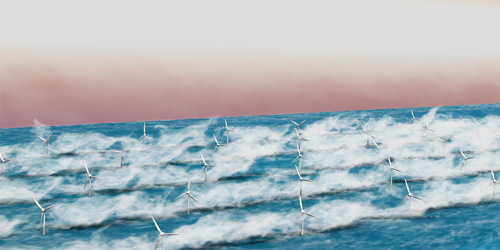Wind Farms Perform Under Pressure
Wind turbines generated about 9.2% of the USA’s utility-scale electricity in 2021, a figure that’s grown exponentially since 1990. To meet future demand, engineers need to optimize wind farm designs by improving their understanding of interactions between wind farms and the local atmosphere. To this end, Anja Stieren, Richard Stevens, and their colleagues at the University of Twente, Netherlands, evaluate how height-varying pressure gradients in the atmosphere influence the exploitation of available local wind resources [1]. Their simulations show reduced power production compared to standard models in which the driving pressure gradient doesn’t vary with height.
Height-dependent variation in the driving pressure gradient —“baroclinicity”—arises due to horizontal temperature transitions, such as in coastal regions or along hillsides. Depending on its alignment with the horizontal temperature gradient, the pressure gradient can steepen, flatten, or change its direction with height.
Stieren and her colleagues address a pressure gradient that decreases with height, producing negative wind shear. Using supercomputer simulations, they capture the large-scale flow features and the small-scale turbulence in and around a grid of wind turbines. The results show that negative wind shear can significantly reduce the wind velocity at turbine height, compared to a situation with no baroclinicity. Additionally, the shearing leads to increased turbulence that drives energy upward, away from the wind farm. Increased turbulence is usually beneficial for wind farm performance, so the researchers were surprised to find a case in which turbulence reduces performance. They say that accounting for such effects of baroclinicity will help engineers improve the layout and efficiency of wind farms.
–Rachel Berkowitz
Rachel Berkowitz is a Corresponding Editor for Physics Magazine based in Vancouver, Canada.
References
- A. Stieren et al., “Impact of negative geostrophic wind shear on wind farm performance,” PRX Energy 1, 023007 (2022).




